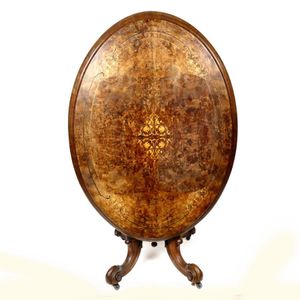Victorian Walnut Loo Table with Satinwood Inlay
You must be a subscriber, and be logged in to view price and dealer details.
Subscribe Now to view actual auction price for this item
When you subscribe, you have the option of setting the currency in which to display prices to $Au, $US, $NZ or Stg.
- Satinwood - Satinwood is a dense pale gold coloured timber that was imported into Britain in the second half of the 18th century, and early 19th centuries from the East Indies and the West Indies. The name derives from the satin-like surface sheen when the timber is polished.
It was used in the solid, as a veneer and in inlays. As well as furniture, satinwood was used for making musical instruments, barometers, boxes and clocks.
It will usually be found on only the very best quality objects, presumably because of of its cost at the time. - Parquetry - Parquetry is inlay laid in geometric patterns, the contrast being achieved by the opposing angles of the grain and veneers. The herringbone pattern is the most commonly used in flooring, but this is almost never seen in furniture - the patterns used are more complex and unlike flooring, can include several different varieties of timber.
- Foliate - Decorated with leaves or leaf-like forms.
- Inlay - Decorative patterns inserted into the main body of a piece of furniture, generally in wood of contrasting colour and grain, though brass, ivory, ebony, shell and sometimes horn have been used. Inlay may consist of a panel of well figured timber inset into a cabinet door front, geometric patterns, or complex and stylized designs of flowers, swags of foliage, fruits and other motifs. As a general rule, in pieces where the carcase is constructed in the solid, the inlay is relatively simple such as stringing, cross banding and herringbone banding. Where more elaborate and decorative work was required veneer was used. Inlay has been fashionable from at least the latter half of the 17th century, when a variety of elaborate forms were developed
- Victorian Period - The Victorian period of furniture and decorative arts design covers the reign of Queen Victoria from 1837 to 1901. There was not one dominant style of furniture in the Victorian period. Designers used and modified many historical styles such as Gothic, Tudor, Elizabethan, English Rococo, Neoclassical and others, although use of some styles, such as English Rococo and Gothic tended to dominate the furniture manufacture of the period.
The Victorian period was preceded by the Regency and William IV periods, and followed by the Edwardian period, named for Edward VII (1841 ? 1910) who was King of the United Kingdom and the British Dominions and Emperor of India for the brief period from 1901 until his death in 1910.
This item has been included into following indexes:
Visually similar items

A Victorian walnut loo table with quartered veeners and foliate satinwood inlay and stringing on a cathedral base. Some veneer damage. Height 690. Length 130 cm. Width 100 cm

A Victorian loo table, the highly figured oyster shell veneered oval top with fine satinwood inlays and ebony stringing, raised on an ornate cathedral base. Width 136 cm, depth 98 cm, height 760 mm.

A Victorian marquetry inlaid walnut loo table. 72 cm high, 133 cm wide, 96 cm high

An Australian circular cedar supper table, circa 1835, 76 cm high, 113 cm diameter
